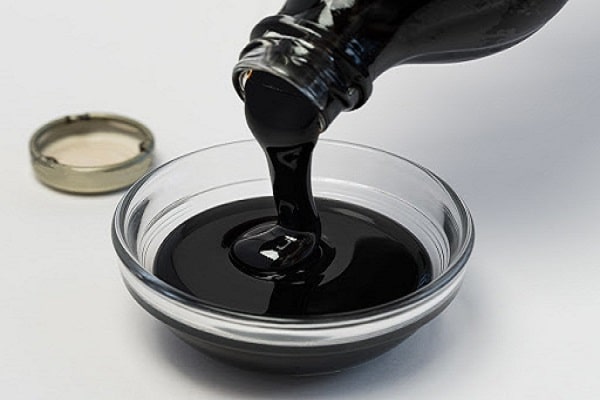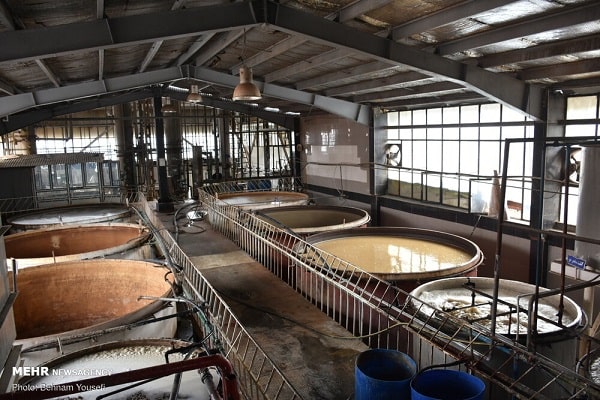Molasses knew. In the past, molasses was sweeter than today and was used for human consumption. White sugar is also consumed in There were official ceremonies and special classes.
Molasses:
The value of molasses was such that in 1812, the survival of sugar mills depended entirely on the selling rate of molasses for the production of alcohol and the effluent of distilleries for the production of potassium carbonate. With the establishment of the first sugar factory in Iran in 1274 AH in Kahrizak, molasses was produced and marketed, but this product was not considered and was considered as waste and entered the sewage.
The influx of molasses into sewers caused severe pollution of the environment and rivers around sugar factories, such as the Barfabad River in the west. The first molasses sugaring unit in Iran started working in Shirvan sugar factory by Stephen method. In 1340, about 900 tons of sugar was obtained from 4000 tons of molasses produced in this factory. Since then, it has become common to use this method to prevent the loss of molasses sugar.
Sugar factories also moved towards the production of dry pulp with molasses as livestock fodder and the use of molasses in alcohol and yeast factories. Molasses production in sugar beet factories is 4-7% of the weight of consumed beets and in sugarcane factories is 3.7 – 2.7% by weight.

Applications of molasses:
1- The use of molasses in the alcohol industry, 2- The use of molasses in the preparation of sourdough, 3- The use of molasses in the production of citric acid 4- Production of lactic acid, 5- Production of glycerin and 6- Production of animal feed.
Based on the production of alcohol from molasses, the fermentation of molasses sugar by yeast at a temperature of 20-25 degrees and its conversion into alcohol and carbon dioxide is theoretically 58 liters of alcohol is obtained from every 100 kg of sucrose. It is the main and almost the only raw material for the production of bakery yeast. In the production of lactic acid in the food industry in confectionery It is used in making compotes, bakeries, cakes, soft drinks and finally in the pharmaceutical industry.
Lactic acid It can be easily obtained by fermenting sucrose at 50 degrees. Also in the conventional method of glycerin production based on fracture
Fat molecules are stable, but only moderate 10-15% of the weight of fat consumed is glycerin (saponification of fats with alkali). Glycerin can be obtained from a relatively cheaper raw material molasses by fermentation with yeasts. In fermentation of sugar with yeasts, there are various intermediate steps, of which glycerin is one of the products of these intermediate steps.
Description of alcohol production line:
At the beginning of the line, raw molasses storage tanks are where raw molasses is stored by adding compounds in these tanks. Then there is the solution stage, in which molasses is combined with water and other compounds in the solution tanks and enters the next stage.
The next stage of the fermentation process varies depending on the type and percentage of alcohol required. This process is performed by fermenter devices with bioreactors in several steps. The solution is transferred into the fermenter by the pumping system.
Fermentation is started by dissolving a certain weight of dry yeast dough in a tank and then transferring it to the pre-fermenter, then the first fermenter is transferred and the fermentation process is performed step by step until the fifth fermenter. Then, after the fermentation process, the solution enters the storage tank and is stored so that in the next stage, which is distillation, this process can be done continuously.
Ethanol increases in concentration during the fermentation process and then reaches the distillation stage. The distillation process consists of six tray towers by which the separation and distillation steps are performed. The final product after this process is medical alcohol, industrial alcohol and alcohol oil.

Methods of production of ethyl alcohol
Ethanol is produced by both synthetic and fermentation methods. In the synthetic production method, this substance is extracted from petroleum products and in the fermentation method, foods and plants containing sugar are used. Most of the ethanol produced in the world (about 93%) is produced by the fermentation method and only about 7% by the artificial method.
It should be noted that of the total alcohol production in the world by fermentation, about 65% is obtained by fermentation of by-products of the sugar industry and another 35% by fermentation of other sugars such as corn, wheat, dates and so on.
The following processes of ethanol production are studied.

Production of ethyl alcohol by synthetic method
Synthetic ethanol is produced by two methods of direct and indirect hydration of ethylene. The process of indirect hydration is older than direct hydration and is more than one hundred years old. In this method, first the hydrocarbon feed containing 35 to 95% of ethylene is exposed to 95 to 98% of sulfuric acid and produces mono and diethylene sulfate.
The mixture is then hydrolyzed with water to give a solution of 50 to 60 degrees sulfuric acid:
Ethanol is then separated from dilute sulfuric acid in a separation tower and the acid is returned to the process after concentration. The direct hydration process was industrially exploited in 1947. In this process, ethylene-rich gas is mixed with water and converted to ethanol after passing through the catalyst.
There are several other processes for the synthesis of ethanol that are not of industrial importance.
Production of ethyl alcohol by fermentation method
Fermented ethanol can be produced from a variety of raw materials. These substances are classified into three categories: sugary, starchy and cellulosic compounds.
Sugary raw materials are usually converted directly to ethanol by microorganisms, while starch and cellulose must first be hydrolyzed to sugar and then fermented to ethanol in the fermentation process.
Production of alcohol from sugary compounds
Currently, this group is the most important raw material for alcohol production in Iran. Among this group, molasses (sugar beet and sugarcane) is the most important source of cheap hydrocarbons. Molasses is made from sugar beet and sugarcane in sugar factories, which contain about 36% of sugar that can be converted into alcohol. (In the case of beet molasses, the sugar content is 51%.) In this process, molasses is first diluted with water and then fermented by yeast and turned into alcohol. The process of fermentation and production of alcohol from sugar is done according to the following equation.
Theoretically, according to the above relation, 511 grams of alcohol can be produced from each kilogram of sugar in molasses. However, the efficiency of the process in practice is lower due to the production of by-products such as microorganisms and some other chemical products and will be between 400 and 460 grams of alcohol per kilogram of sugar. Therefore, in theory, it can be said that every 14-15 kg of sugarcane molasses produces about one kg of alcohol. The microorganism (yeast) used in the industrial processes of ethanol production from molasses is the yeast of Baker’s yeast or Saccharomyces cerevisiae.
Production of alcohol from starchy compounds
Alcohol production from starchy compounds such as corn, potatoes and wheat usually takes place in two stages (simultaneous or consecutive).
Starch is a polymer of glucose monomers. The reaction of the first step, which is the breaking of this polymer to its primary monomers, can be done in two ways, acidic and enzymatic. In the first method, sulfuric acid is generally used and in the second method, alpha-amylase enzyme is used for hydrolysis of starch.
Due to the reasonable price of alpha-amylase and the high efficiency of the enzymatic method, the acidic method is almost obsolete in the world.
In the second stage, which is very similar to the process of production of alcohol from sugar compounds, the glucose obtained in the first stage is converted into alcohol by yeasts.
Production of alcohol from cellulosic compounds
Cellulose compounds such as wood, forest waste, agricultural waste and recycled paper contain lignocellulose. Alcohol is produced from lignocellulosic compounds in two stages. In the first stage, called hydrolysis, the cellulose and hemicellulose polymers are broken down into their monomers, and the resulting sugar solution is fermented in the second stage. Hydrolysis of lignocellulose can be done by either acidic or enzymatic methods.
Ethanol product packaging and storage step:
After preparation, the alcohol is packaged in a bottle and stored in this warehouse with suitable environmental conditions
Source:
Tabriz Daneshvaran Food Industries Group
